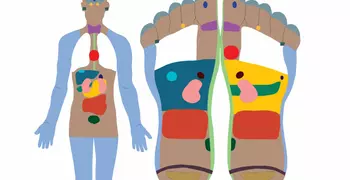Acupuncture and Traditional Chinese Medicine
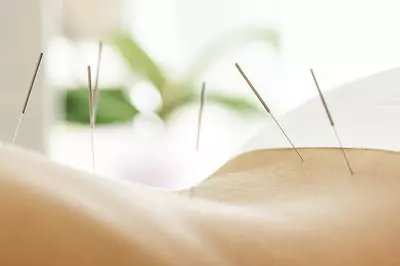
What Is Acupuncture?
Acupuncture is the insertion of very fine, filiform needles through the skin at specific points on the body with the intention of manipulating Qi. The filiform needles are solid, as opposed to the hollow hypodermic needles most people are familiar with, and are usually made of stainless steel, but can also be gold or silver.
How does Qi flow through the body?
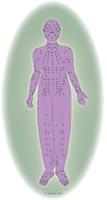 Acupuncture is based upon the jing luo channel network theory of the circulation of Qi. Although Qi permeates every part of the body, it tends to collect and travel along channels called "jing luo." These are the so-called "meridians" of acupuncture.
Acupuncture is based upon the jing luo channel network theory of the circulation of Qi. Although Qi permeates every part of the body, it tends to collect and travel along channels called "jing luo." These are the so-called "meridians" of acupuncture.
The jing luo channel system connects all aspects of the body together into one network of energetic communication.
Just as water flowing through a landscape tends to seek the path of least resistance, so Qi flows through the body. The flow of Qi follows the folds and creases of the body's landscape. It follows the divisions between muscles and the clefts between muscles and bones, collecting in the small hollows and depressions of the body to form pools of Qi.
These "pools of Qi" are places where Qi is concentrated and more accessible. They are the acupuncture points, where Qi can be accessed and manipulated through the use of finger pressure (acupressure), massage techniques (tui na; literally "pinch and pull"), dermal friction (gua sha), cupping, moxibustion (a form of heat therapy), and, of course, acupuncture.
How does the practitioner manipulate Qi?
The successful manipulation of Qi begins by contacting the Qi in the channel at one or more of the points being needled. This is called "obtaining the Qi" and is heralded by the arrival of the "Qi sensation."
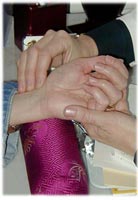 The patient typically feels the Qi sensation locally around the needle site and then in adjacent areas, usually along the associated channel. It has been described as a dull, heavy, aching, or mildly electrical sensation that spreads in wave-like patterns. Most people do not find the Qi sensation to be painful or unpleasant, just unusual.
The patient typically feels the Qi sensation locally around the needle site and then in adjacent areas, usually along the associated channel. It has been described as a dull, heavy, aching, or mildly electrical sensation that spreads in wave-like patterns. Most people do not find the Qi sensation to be painful or unpleasant, just unusual.
An experienced acupuncturist can usually feel the patient's Qi through the needle once it arrives at the site. Once the practitioner has obtained the Qi and successfully manipulated it, the needles are removed. The entire process can take anywhere between just a few minutes to over an hour, depending on the condition of the patient. Most acupuncture treatments last about twenty minutes.
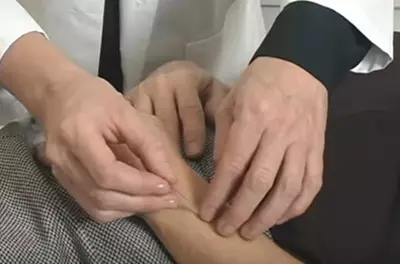
Acupuncture video
Watch a video of an acupuncture treatment.
What should I expect after the treatment?
Most patients feel pleasantly relaxed and refreshed after an acupuncture treatment. Patients who were experiencing pain before the acupuncture session are often pleasantly surprised to find their discomfort greatly reduced after the treatment.
When is acupuncture used?
TCM practitioners use acupuncture to treat a wide range of conditions. Some of the conditions for which acupuncture is commonly used include:
- Pain
- Injury
- Trauma
- Repetitive strain conditions like tennis elbows and carpal tunnel syndrome
- Headache
- Rheumatoid and osteoarthritis
- Back pain and sciatica
- Fibromyalgia
- Dysmenorrhea and other gynecological conditions
- Asthma
- Post operative and chemotherapy nausea
- Stroke rehabilitation
- Patients undergoing recovery from addiction and substance abuse
What are the possible side effects of acupuncture?
Side effects are rare. Patients may occasionally experience slight bruising at the point of needle insertion.
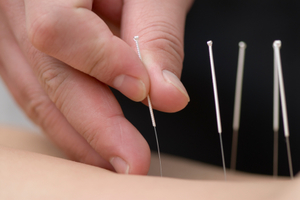 "Needle Shock": a feeling of faintness, chilliness and perhaps slight nausea. Needle shock happens rarely, but when it does, it is most likely to happen in situations in which the patient is very nervous about the needles, is extremely exhausted or fatigued, or is experiencing low blood sugar from not having eaten for a long period of time before the acupuncture treatment.
"Needle Shock": a feeling of faintness, chilliness and perhaps slight nausea. Needle shock happens rarely, but when it does, it is most likely to happen in situations in which the patient is very nervous about the needles, is extremely exhausted or fatigued, or is experiencing low blood sugar from not having eaten for a long period of time before the acupuncture treatment.
Needle shock can be disquieting to the patient but is not considered harmful. Most states that regulate acupuncture require practitioners to provide informed consent forms outlining these possible side-effects.
When shouldn't acupuncture be used?
The use of acupuncture is not as prominent or may even be contraindicated in the treatment of:
✔ Infants and very young children
✔ Very weak or very elderly patients
✔ People with compromised immunity
✔ Patients suffering with certain bleeding disorders or severe blood loss
✔ Patients who are very weak, emaciated, who are suffering from low blood sugar, or who have collapsed due to fatigue and exhaustion
✔ Patients with significantly low blood pressure
✔ Patients who are suffering with extreme anxiety or who are very nervous about the needles
✔ Pregnancy: while acupuncture is generally considered safe for most women during pregnancy, there are certain acupuncture points that are forbidden during pregnancy. Pregnant women should talk with their OB-GYN doctor and their TCM practitioner about these restrictions and any other concerns regarding their pregnancy before undergoing an acupuncture treatment.

